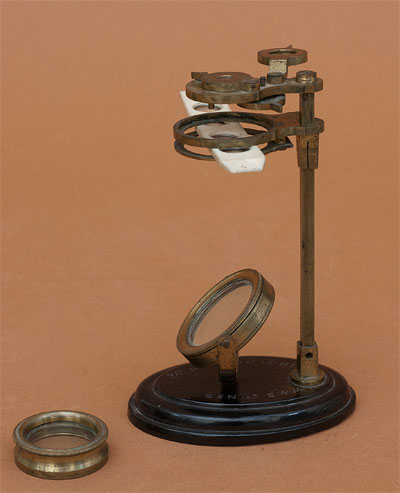This is a "Botanical Microscope" made by Williams and Samuel Jones c1760. The body consists of a single square pillar that supports the sliding stage, for focusing, and is topped by a brass cantilever that holds three objectives. Each of the objectives is mounted on an arm that allows it to be swung into place above the sample. From one to all three objectives may be used at one time. The stage consists of a thick brass top piece and a thinner spring stage below. Spaces between the two pieces allow a sample slide to be slipped in and maintained in place by friction. Focusing is accomplished by sliding the stage along the main support pillar. The pillar fits into a square base that itself is screwed to the oval ebony base. The pillar is held in position by a pin (now missing). Also mounted on the base is the illuminating mirror. It has only one parabolic reflecting surface. The microscope may be stored in a rectangular carrying case with a rounded top. The case is lined with purple velvet and is covered in red fish skin. On the base is stamped "W&S Jones, 30 Holborn London". The complete instrument is 10cm. Accessories include four bone slides, a stage forceps, and a separate brass forcep. Imaging is good for a field botanical microscope, and ranges from approximately 3x to 15x.
The Botanical Microscope was derived from the earlier "Aquatic Microscope". It differs in its focusing mechanism. The aquatic microscope used a rack & pinion focusing mechanism to move the single objective without moving, and subsequently disturbing, aquatic life that was being observed. The Golub Collection has two examples of Aquatic microscopes by Raspail (No. 235 and 287).
From 1776 through 1794 William (1762Ð1831) was an apprentice to his father, John Jones Jr. in the Spectaclemaker's Company. During this apprenticeship William was also a pupil of Benjamin Martin and at some point was employed by George Adams Jr. By 1784 he had joined his father making instruments as "Jones and Son", and by 1794 he and his brother, Samuel, formed the firm of W&S Jones. This firm made scientific instruments from 1794 until 1838 first at 135 Holborn then at 30 Holborn (in 1799). The company was well known for making optical instruments such as their upright, solar, lucernal, and simple microscopes, as well as a planetarium with a clockwork movement.
This microscope was featured 10/2014






